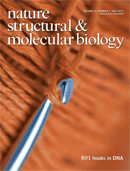Advertisement |
 |
npj Molecular Phenomics is an online-only, open access journal that provides a forum for cutting-edge scientific advances in the emerging field of phenomics, the study of the physical and chemical characteristics of an individual in quantitative terms.
Part of the Nature Partner Journals series, npj Molecular Phenomics is published in partnership with Fudan University. The journal is now open for submissions.
Find out more >> |  | |
 |
 |
TABLE OF CONTENTS
|
July 2017 Volume 24, Issue 7 |
 |  |  |
 |  Editorial Editorial
 News and Views News and Views
 Articles Articles
 Brief Communication Brief Communication | |
 |
|
 |
 |
| Advertisement |
 |
| |
 |
| |
Editorial |  Top Top |
 |
 |
 |
Open-door policies p555
doi:10.1038/nsmb.3438
Nature research journals announce new reporting summaries to promote transparency, and our editors welcome early-career researchers to the Springer Nature office in New York to discuss careers in scientific publishing. |
 |
News and Views |  Top Top |
 |
 |
 |
|
 |
Articles |  Top Top |
 |
 |
 |
RNA fate determination through cotranscriptional adenosine methylation and microprocessor binding pp561 - 569
Philip Knuckles, Sarah H Carl, Michael Musheev, Christof Niehrs, Alice Wenger et al.
doi:10.1038/nsmb.3419
Microprocessor components Dgcr8 and Drosha associate with transcriptionally active coding and noncoding genes in a Mettl3-dependent manner and, upon temperature stress, relocate to heat-shock genes, where they mark mRNAs for subsequent degradation. |
 |
 |
 |
Structural basis for the cooperative allosteric activation of the free fatty acid receptor GPR40 pp570 - 577
Jun Lu, Noel Byrne, John Wang, Gerard Bricogne, Frank K Brown et al.
doi:10.1038/nsmb.3417
Crystal structures of hGPR40, a target for treatment of type 2 diabetes, bound to a partial and an allosteric agonist explain the binding cooperativity between these ligands and present new opportunities for structure-guided drug design. |
 |
 |
 |
Structural analysis of MDM2 RING separates degradation from regulation of p53 transcription activity pp578 - 587
Koji Nomura, Marta Klejnot, Dominika Kowalczyk, Andreas K Hock, Gary J Sibbet et al.
doi:10.1038/nsmb.3414
MDM2 mutations that prevent E2-ubiquitin binding without altering RING domain structure lead to loss of E3-ligase activity, while the ability to limit p53 transcriptional activity is retained, allowing cells to respond more quickly to cellular stress. |
 |
 |
 |
Rif1 maintains telomeres and mediates DNA repair by encasing DNA ends pp588 - 595
Stefano Mattarocci, Julia K Reinert, Richard D Bunker, Gabriele A Fontana, Tianlai Shi et al.
doi:10.1038/nsmb.3420
Structure determination and functional analyses of budding yeast Rif1 reveal a novel, hooked N-terminal DNA-binding domain required for telomere maintenance and checkpoint control and show that Rif1's role in DNA-repair pathway choice is conserved in yeast and mammalian cells. |
 |
 |
 |
Chromatin-enriched lncRNAs can act as cell-type specific activators of proximal gene transcription pp596 - 603
Michael S Werner, Matthew A Sullivan, Rohan N Shah, Rangarajan D Nadadur, Adrian T Grzybowski et al.
doi:10.1038/nsmb.3424
Functional characterization of chromatin enriched lncRNAs (cheRNAs) reveals their role as cis-acting transcriptional activators that couple enhancers at sites of cheRNA synthesis to promoters of proximal target genes.
See also: News and Views by Gayen & Kalantry |
 |
Brief Communication |  Top Top |
 |
 |
 |
A MILI-independent piRNA biogenesis pathway empowers partial germline reprogramming pp604 - 606
Lina Vasiliauskaite, Dimitrios Vitsios, Rebecca V Berrens, Claudia Carrieri, Wolf Reik et al.
doi:10.1038/nsmb.3413
MILI-mediated piRNA processing and amplification is not essential for all MIWI2 male germline reprogramming activity, indicating the existence of a MILI-independent piRNA biogenesis pathway. |
 |
 Top Top |
 |
 |
 |  |  |  |  |  | Natureevents is a fully searchable, multi-disciplinary database designed to maximise exposure for events organisers. The contents of the Natureevents Directory are now live. The digital version is available here.
Find the latest scientific conferences, courses, meetings and symposia on natureevents.com. For event advertising opportunities across the Nature Publishing Group portfolio please contact natureevents@nature.com |  |  |  |  |  |
|
 |


No comments:
Post a Comment